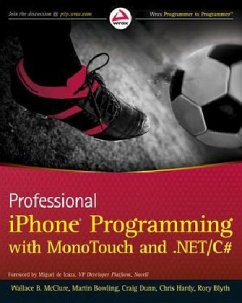What .NET C sharp developers need to enter the hot field of iPhone apps iPhone applications offer a hot opportunity for developers. Until the open source MonoTouch project, this field was limited to those familiar with Apple's programming languages. Now .NET and C sharp developers can join the party. Professional iPhone Programming with MonoTouch and .NET/C sharp is the first book to cover MonoTouch, preparing developers to take advantage of this lucrative opportunity. This book is for .NET developers that are interested in creating native iPhone applications written in .NET/C sharp. These developers want to use their existing knowledge. While .NET developers are always interested in learning, they also recognize that learning Objective-C and the specifics of the iPhone can be overwhelming. Those developers interested in MonoTouch will recognize that the cost of MonoTouch is easily made up by the ability to quickly target the iPhone using a language that they are already familiar with. This book is designed for .NET developers that want to target the iPhone. It is designed to help you get up to speed with the iPhone, not to really teach you about the .NET Framework or C sharp language, which we assume you already know. This book is designed with introductory material in Chapters 1 thru 4. You should read Chapters 1 thru 4 sequentially. These chapters introduce the MonoTouch product, the basics of developing with MonoTouch and MonoDevelop, and finally, the basics of presenting data to a user with screen and data controls and how to develop a user interface for the iPhone. Once you are comfortable with these concepts, you can typically move from one chapter to another and not necessarily have to read the chapters sequentially. Chapter 1 "Introduction to iPhone Development with MonoTouch for C sharp Developers"This chapter looks at how the largest segment of developers can target the smartphone with the highest mindshare, and that the smartphone is growing faster in marketshare than any other device. Chapter 2 "Introduction to MonoTouch"gives you a firm foundation in MonoTouch, MonoDevelop, Interface Builder, debugging, and deploying. Chapter 3 "Planning Your App's UI: Exploring the Screen Controls"teaches you about creating your application's UI and specifically how the UI on the iPhone can differ from UIs that you might have created before. You also explore the Input & Value objects from the Interface Builder Objects Library. Chapter 4 "Data Controls" shows the Interface Builder Objects Library Cocoa Touch classes for Controllers, Data Views, and Windows, Views, & Bars. Chapter 5 "Working with Data on the iPhone"looks at the SQLite database engine as well as strategies to store data off the device on a central server through SOAP and REST (using XML and JSON) without tying up the user interface. Chapter 6 "Displaying Data Using Tables"looks at displaying information in a table, using tables for navigation, taking advantage of UITableView's built-in editing features, and adding a search bar to a table. Chapter 7 "Mapping"covers CoreLocation and MapKit, using Location Services, and adding maps and geocoding to your application. Chapter 8 "Application Settings"focuses on application settings, and looks at two aspects of settings for your MonoTouch app: the Info.plist and your settings bundle. It covers what settings you might want to set in your Info.plist and why, and then looks at what code it takes to read and use the settings that you save in the settings bundle. And it also takes you through the building of the settings that you might have in a social media-type application. Going through each step, you will examine the Root.plist inside the Property List Editor and see the settings dialog that will result from it. Chapter 9 "Programming with Device Hardware" covers accelerometer device orientation, and proximity detection support, networking, and developing with battery life in mind. Chapter 10 "Programming wit
Bitte wählen Sie Ihr Anliegen aus.
Rechnungen
Retourenschein anfordern
Bestellstatus
Storno

